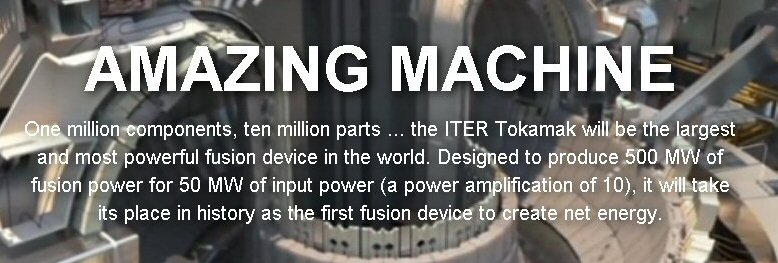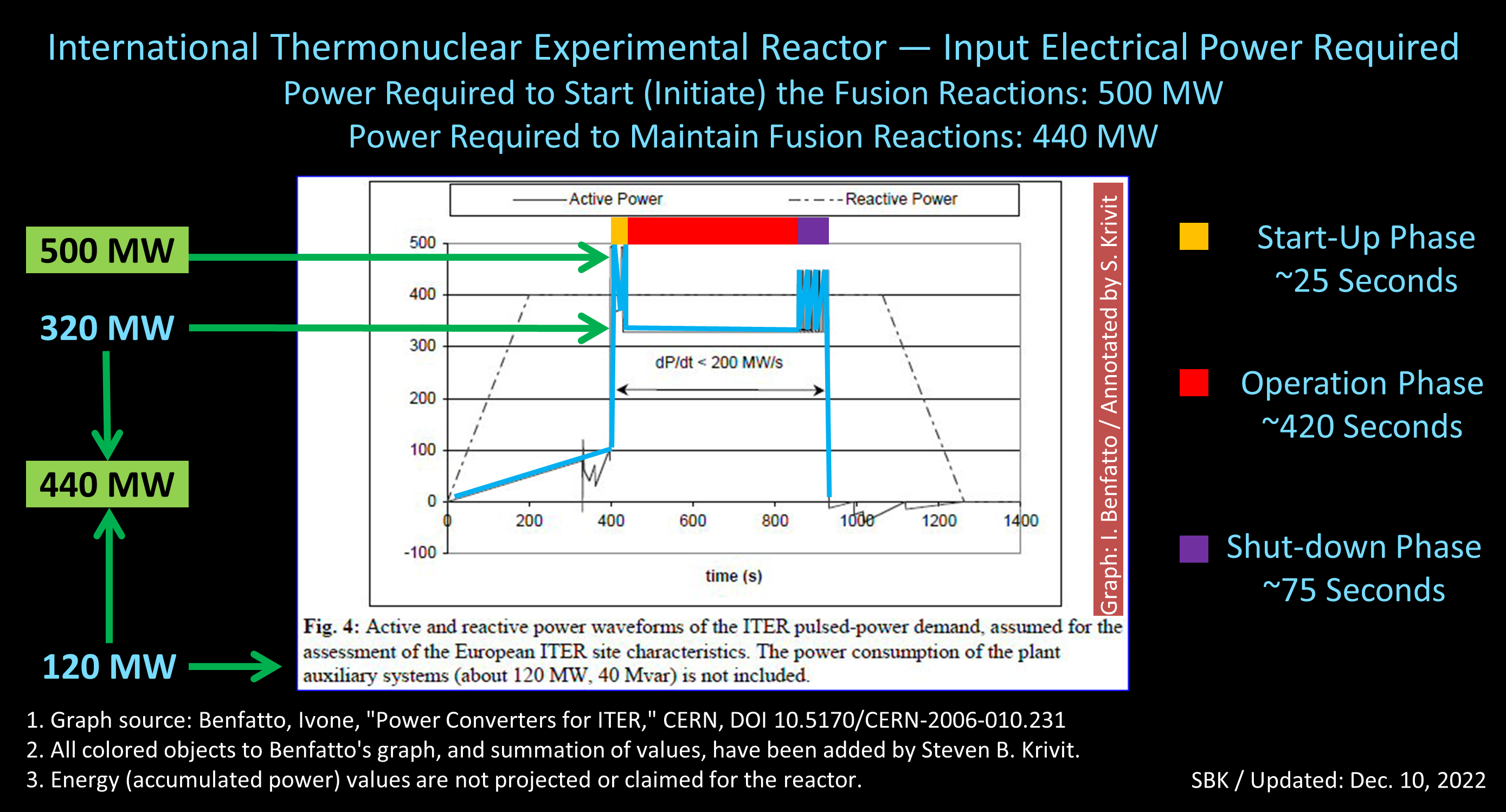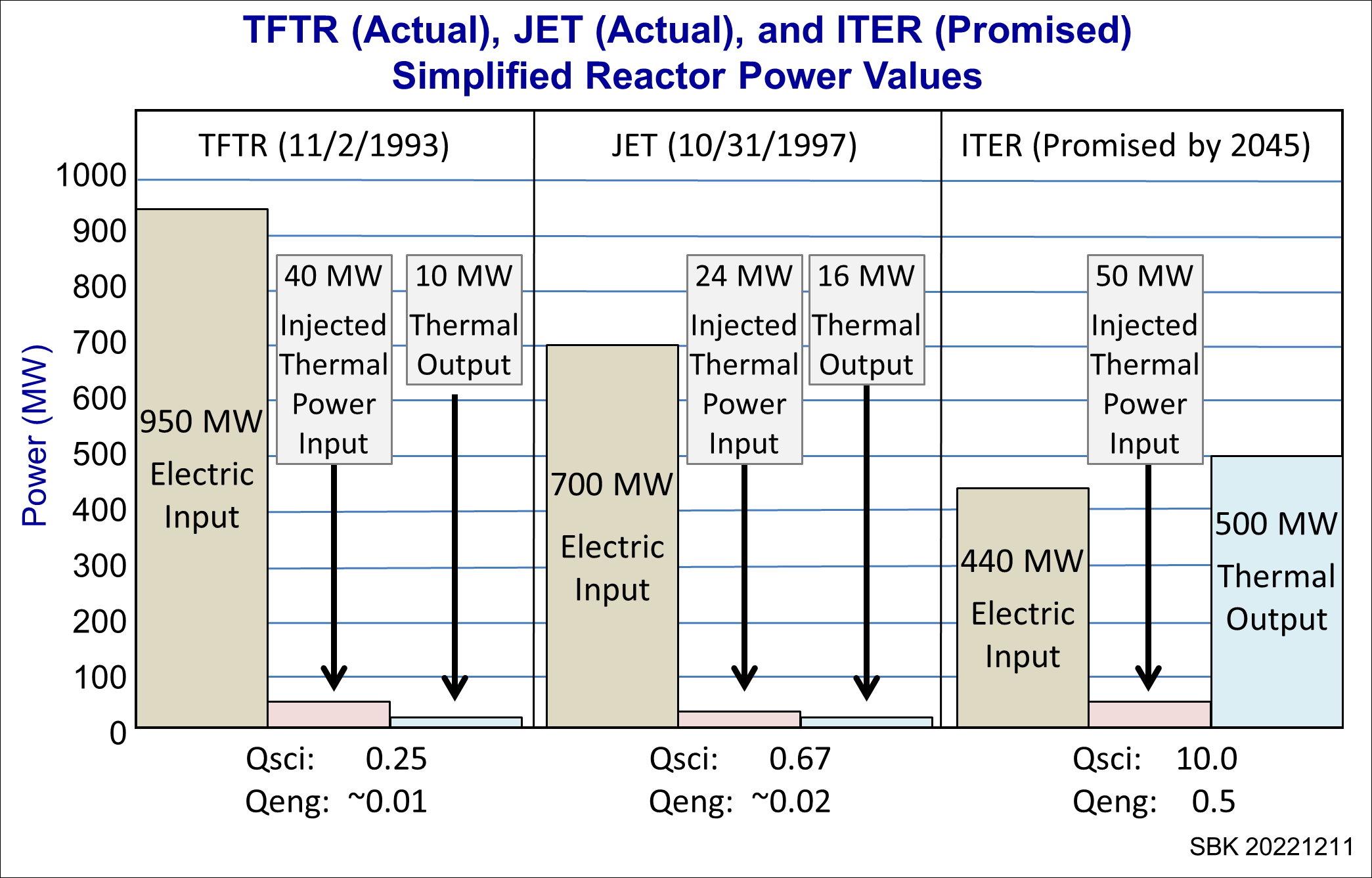Steven B. Krivit’s Fusion Reactor Power Value Research
Return to ITER Power Facts Main Page
For decades, promoters of the International Thermonuclear Experimental Reactor, ITER, stated or implied that the reactor would need only 50 megawatts of input power to produce a thermal output of 500 megawatts from the fusion reactions.
On Dec. 1, 2014, Steven B. Krivit, publisher of New Energy Times, learned that the claimed 50-megawatt value was much too low to be accurate. Because he was in the middle of writing a three-book series about low-nuclear reaction research, he did not immediately investigate the ITER power discrepancy.
In December 2016, Krivit located a scientific paper and slide presentation by Ivone Benfatto that discussed the electrical input power that would be required for ITER. Benfatto is the head of the Electrical Engineering Division for the ITER organization. Benfatto did not, however, provide a simple, single number for the total reactor input power requirement. Instead, he displayed a graph and a caption with three sets of power values: active, reactive, and auxiliary. Benfatto did not respond to Krivit’s request for clarification. Krivit sent a request to Bernard Bigot, the former director-general of the ITER organization, and Laban Coblentz, his head of communications, for the correct value. Coblentz provided an ambiguous response.
In the summer of 2017, Krivit contacted independent fusion experts, who said that a minimum of 300 megawatts of electricity would be required to operate the ITER reactor. Krivit published this finding on Oct. 6, 2017. By November 2020, Krivit began to understand the Benfatto graph better and to suspect that the more accurate number was 440 MW, instead of 300 MW. In June 2021, French journalist Celia Izoard located a reference that identified the input power as 450 MW. Krivit located a third concurring reference indicating the power consumption to be in the 400-500 megawatt range.
After Bigot died and Pietro Barabaschi took over as director-general, Krivit tried again for confirmation from Benfatto. In an e-mail to Krivit on Dec. 7, 2022, carbon-copied to Barabaschi and Benfatto, Coblentz concurred with Krivit’s analysis of the Benfatto graph, that the overall reactor is expected to consume 440 MW of electricity during plasma operation. At that time, Coblentz denied that ITER’s plant-wide power balance was relevant to the anticipated power balance of any future commercial fusion machine. It was a significant walkback to the claims Coblentz had made on the ITER Web site in the past.

Second gallery image on the ITER organization’s Web site home page as of Jan. 12, 2017 (Removed as of Oct. 31, 2022)
RESULTS OF KRIVIT’S RESEARCH TO DETERMINE ITER TOTAL ELECTRICAL INPUT POWER VALUE
Source 1: Japanese JT-60SA Fusion Team (200 MW – 325 MW)
“Will ITER make more energy than it consumes? … ITER is about equivalent to a zero (net) power reactor, when the plasma is burning.” Archive Copy
Source 2: UCSD Plasma Physics Professor (270 MW interpolated by adding 120 MW from Gascón)
E-mail to Krivit, Dec. 22, 2016
“To generate 50 MW of the power which goes into ITER (as RF waves and energetic neutral beams) you need to spend at least 150 MW of the heat! In practice even more, since you have energy losses when you generate both RF waves and energetic neutral beams.”
Source 3: Laban Coblentz – ITER Organization Spokesman (270 MW)
E-mail to Krivit, Dec. 24, 2016
“Total energy required to power the heating systems: at Q=10, 50[0] MW of fusion power requires roughly 150 MW of electrical input to the heating systems. For a 400-second pulse, the output of 500 MW fusion power to 150 MW electrical power to the Heating and Current Drive Systems yields a factor of ~3x more energy than is input to the H&CD systems, which more than compensates for “end effects,” where power has to be injected to start the fusion reaction going and to shut the plasma down. Site requirements at steady state will enable the consumption of roughly 120 MW of power to support the plant systems such a cooling, cryogenics, vacuum, Tritium Plant and fuelling, Diagnostics, Test Blanket Modules, etc.”
Source 4: Daniel Jassby (300 MW)
Daniel Jassby is a retired principal research physicist from the Princeton Plasma Physics Laboratory.
Source 5: Hartmut Zohm (330 MW)
Hartmut Zohm is the head of the Tokamak Scenario Development Division at the Max Planck Institute of Plasma Physics.
Source 6: Steve Cowley (300 MW)
Steven Cowley is the current director of the Princeton Plasma Physics Laboratory and former chief executive officer of the United Kingdom Atomic Energy Authority.
Source 7: Jülich Research Centre (260-350 MW)
Source 8: Max Planck Institute for Plasma Physics (350 MW)
(In 2020, Zohm, individually, revised his value to 250 MW.)
Source 9: Robert Arnoux – ITER Organization (300 MW)
Source: “The Balance of Power,” Nov. 28, 2016, news article
“A plasma shot will require an input of 300 MW.”
Source 10: Gascón et. al. (270 MW interpolated by adding 150 for NBI/RF)
They do not state a value for the NBI/RF electrical input, only for balance-of-plant: 120 MW
Source 11: United Kingdom Atomic Energy Authority (274 MW interpolated)
“ITER, should produce about as much fusion power as the electricity required to run the entire plant.” Archive copy
(Interpolation based on hypothetical reactor gross electric output.) [UKAEA has since removed that statement.]
Source 12: Ivone Benfatto (440 MW)- ITER Organization
Source 13: “Débat public sur le projet ITER en Provence” Compte Rendu Du Débat Public ITER En Provence (French National Commission on Public Debate) PDF page 47 (450 MW)
This source was first located by French journalist Celia Izoard.
Source 14: “ITER Technical Basis,” International Atomic Energy Agency, 2002 (500 MW)
“Peak active power 500 MW … from which up to 400 MW is a quasi-steady-state load during the sustained burn phase.”
SOURCES FOR JET TOTAL ELECTRICAL INPUT POWER VALUE
Nick Holloway – UKAEA/CCFE Spokesman (700 MWe)
Email to Krivit, Dec. 1, 2014
SOURCE FOR TFTR TOTAL ELECTRICAL INPUT POWER VALUE
Jan. 14, 1980, Issue of Princeton Alumni Weekly (950 MWe)
“The Tokamak Fusion Test Reactor (TFTR) represents the crucial link between the experimental machines now in use and future prototypes that will actually generate electric power. … “Some observers feel that with an all-out effort and greater funding, commercial fusion power could be available [by 2000.]”



